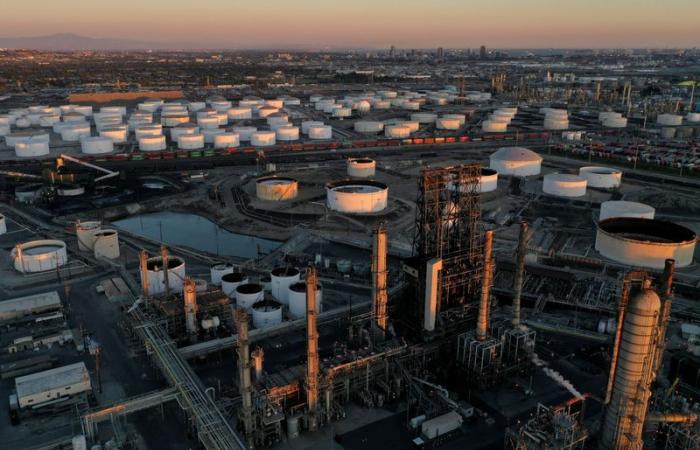Oil refiners are making less money selling their gasoline because demand during the peak summer driving season has not been as expected when many of them increased production.
Weak gasoline markets have ended years of record profits from transportation fuel sales. In the United States, the world’s largest gasoline market, refiners sharply increased production, expecting demand that never materialized. U.S. gasoline demand was 9 million barrels per day (bpd) in the first week of June, 1.7% lower than last year and the lowest level since 2021, according to government data.
In Asia, a weak gasoline market has already led to production cuts, and refiners in other regions are also likely to scale back operations in the coming weeks. This could reduce global demand for crude oil.
“Given the decline in high margins, we believe there is risk to refiners’ continued maximum production strategy aimed at reaping record profits,” BMI, a unit of Fitch Solutions, said in a note last month .
Brent oil prices have fallen about 9% since peaking in mid-April, to around $83 a barrel, recently on concerns that the OPEC+ producer group will increase supply on the walk. Last week, the producers group warned that the slow start to the summer driving season and low margins were weighing on sentiment.
Despite falling crude prices, Asian refiners’ profits from producing gasoline from a barrel of Brent fell by half in the last week of May, to around $4 per barrel. According to Priti Mehta, an analyst at Wood Mackenzie, the decline in refining margins is explained by the glut in fuel supply.
Overall refining margins fell to less than $2 a barrel in Singapore in May, compared with an average of $5 a year ago.
European gasoline refining margins fell to $10.80 per barrel on June 13, their lowest level since January 25. The U.S. gasoline crack margin, that is, the difference between gasoline futures and the cost of WTI crude oil, was less than $22.50 per barrel for the first time since February.
WITHDRAWAL
Taiwan’s Formosa Petrochemical Corp, one of Asia’s largest exporters of refined products, plans to cut production rates at its crude distillation units in June to 440,000 bpd, a drop of 40,000 bpd per year. compared to its initial treatment plan of 480,000 bpd.
“Increased flows from the Middle East to Asia and increased Indian exports are weakening the cracks, but demand in Asia is healthy,” a Formosa spokesperson told Reuters.
U.S. demand has been pressured by a combination of factors, including more people flying instead of driving long distances and the use of more fuel-efficient cars and electric vehicles, UBS analyst Giovanni Staunovo said last month.
Increased production at U.S. refineries, combined with weak demand, has caused U.S. gasoline inventories to increase by 5.7 million barrels since the start of April, to 233.5 million barrels. barrels as of June 7, the highest level during this period since 2021.
U.S. refiners cut their production rates to 95% in the week ended June 7, after using a record rate of 95.4% in the previous week, according to data from the U.S. Energy Information Administration (EIA). This is the first reduction since April.
According to Robert Yawger, analyst at Mizuho, they will have to lower their rates further if demand remains sluggish.
“We are likely to see one of the worst years for summer gasoline demand in the United States in the post-COVID world. There is no way refiners can continue to produce fuels at a utilization rate of 95%,” he said.
On Tuesday, the EIA lowered its forecast for U.S. gasoline consumption this year to 8.89 million bpd, down from a previous estimate of 8.91 million bpd.
A PLETHORIC OFFER
Margins should improve as U.S. gasoline rises, as it typically does during the summer, said Joe DeLaura, a strategist at Rabobank. However, he warned that the market has consistently underperformed.
Margins are expected to be supported by a slower-than-expected ramp-up of new refineries such as Mexico’s Olmeca refinery in Dos Bocas, which aims to reduce the country’s import needs. By May, however, Dos Bocas had fallen behind schedule and was not producing commercially viable gasoline and diesel. In Nigeria, the Dangote refinery delayed its gasoline deliveries until July.
The market has yet to adjust to the significant increase in supply due to the ramp-up of new refineries and expansion of existing facilities, which have boosted fuel exports from the Middle East, India and China.
Gasoline exports from the Middle East have reached seasonal records over the past six months, according to Kpler data.
Indian and Chinese refiners benefit from access to discounted Russian oil, Mehta said. The increased supply is expected to keep pressure on gasoline prices in Asia throughout the summer.
“The peak for gasoline (cracks) was already reached in April, when cracks averaged $17.3 per barrel for Dubai crude in Asia. We don’t expect them to strengthen much over the summer,” Ms. Mehta said.
Chinese gasoline exports increased by about 100,000 bpd in May compared to April, ending last month at about 350,000 bpd, according to WoodMac. Indian gasoline exports averaged 360,000 bpd in May, up 50,000 bpd from the previous month.






